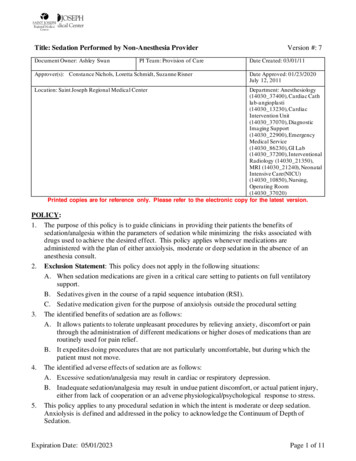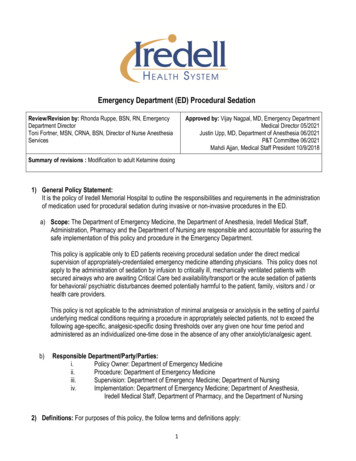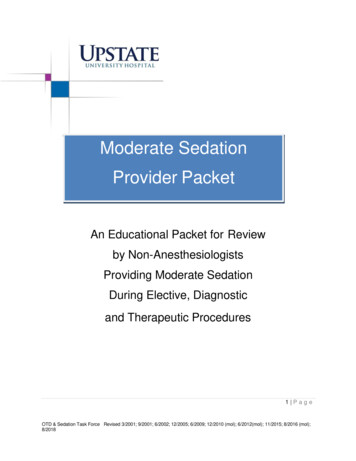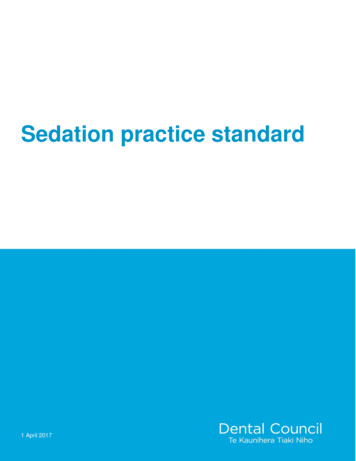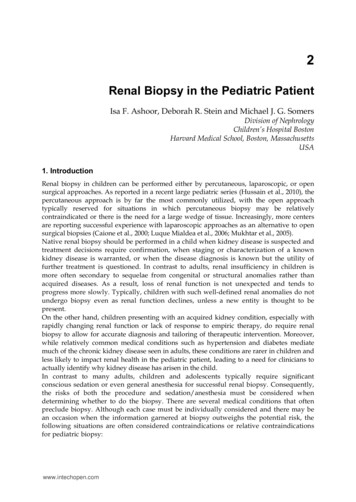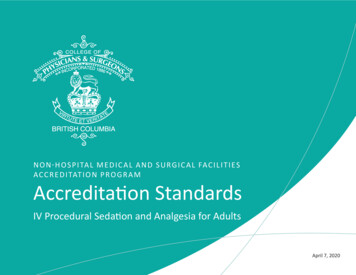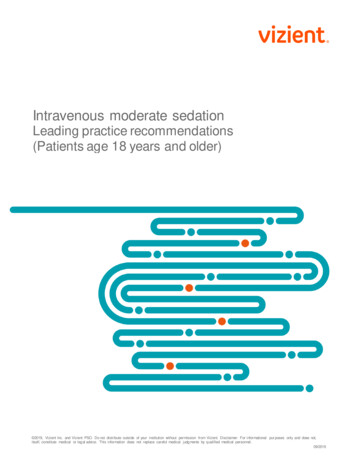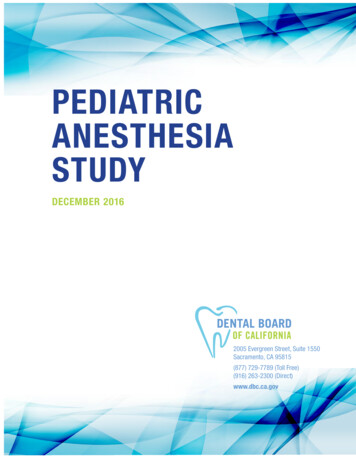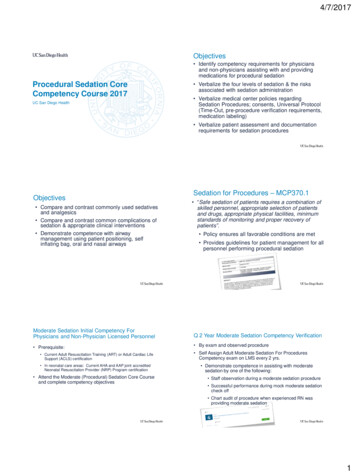
Transcription
4/7/2017Objectives Identify competency requirements for physiciansand non-physicians assisting with and providingmedications for procedural sedationProcedural Sedation CoreCompetency Course 2017UC San Diego Health Verbalize the four levels of sedation & the risksassociated with sedation administration Verbalize medical center policies regardingSedation Procedures; consents, Universal Protocol(Time-Out, pre-procedure verification requirements,medication labeling) Verbalize patient assessment and documentationrequirements for sedation proceduresObjectives Compare and contrast commonly used sedativesand analgesics Compare and contrast common complications ofsedation & appropriate clinical interventions Demonstrate competence with airwaymanagement using patient positioning, selfinflating bag, oral and nasal airwaysSedation for Procedures – MCP370.1 “Safe sedation of patients requires a combination ofskilled personnel, appropriate selection of patientsand drugs, appropriate physical facilities, minimumstandards of monitoring and proper recovery ofpatients”. Policy ensures all favorable conditions are met Provides guidelines for patient management for allpersonnel performing procedural sedationModerate Sedation Initial Competency ForPhysicians and Non-Physician Licensed PersonnelQ 2 Year Moderate Sedation Competency Verification Prerequisite: By exam and observed procedure Current Adult Resuscitation Training (ART) or Adult Cardiac LifeSupport (ACLS) certification In neonatal care areas: Current AHA and AAP joint accreditedNeonatal Resuscitation Provider (NRP) Program certification Attend the Moderate (Procedural) Sedation Core Courseand complete competency objectives Self Assign Adult Moderate Sedation For ProceduresCompetency exam on LMS every 2 yrs. Demonstrate competence in assisting with moderatesedation by one of the following: Staff observation during a moderate sedation procedure Successful performance during mock moderate sedationcheck off Chart audit of procedure when experienced RN wasproviding moderate sedation1
4/7/2017Sedation Competency Exceptions Physicians who routinely practice alllevels of sedation Area / Specialties: Anesthesiology, ED, Trauma, PulmonaryCritical Care, Neurocritical Care, andNeonatal Intensive Care Residents practicing in above areas whileunder direct supervision of attendingphysician within specialty Certified Registered Nurse Anesthetist(CRNA)Sedation Policy Policy does not apply to sedationused in ICU for intubated patientsunless the patient is or may becomedeeply sedated when additionalsedatives and/or analgesics aregiven to facilitate a procedure Example: Bronchoscopy via endotracheal tube Manage patient assessments anddocumentation in same manner andfrequency as procedural sedation Credentialed for Moderate and DeepSedationUCSD Medical Center Policy 370.1Attending Physician Competence In addition to Moderate SedationInitial Competency Requirementsand Prerequisites: Must have Medical Staff AttendingMembership status Must be granted the privilege toperform moderate sedation via thecredentialing process Apply for the privilege per theDepartmental Delineation ofPrivileges form via the Credentialingprocess of the Medical Staff.Fellow and Senior Resident SedationCompetence In addition to Moderate Sedation Initial CompetencyRequirements and Prerequisites: Fellows and residents who are 3rd year or above in residencyor fellowship with active CA Medical License may administer (ifnot participating in the procedure) or direct moderate sedationunder the guidance of a physician First 3 moderate sedations procedures must be proctored byan Attending Physician privileged in Moderate Sedation Endorsed by Training Program Director & MSEC Competency listed on the “Resident Procedure Competencies”or New Innovations websiteUCSD PhysicianPrivileges From Webref or IntranetSearch Clinical Tools or “PhysicianPrivileges” Intern/Resident/Fellows Link to use “ New Innovations” site If unable to locate physiciancompetency in New Innovations, CallHouse Supervisor2
4/7/2017Physician’s, Residents and Fellows NotCredentialed in Moderate Sedation May perform sedation for procedure only underdirect observation of a supervising attendingphysician The supervising attending physician must becredentialed to perform moderate sedation The supervising attending physician must be presentin the procedural area for the duration of theoperation/procedureNon-Physician Licensed Personnel(NP, PA-C, RN) American Association of Moderate Sedation Nurses(AAMSN) teaches the position that registered nursestrained and experienced in critical care, emergencyand/or peri-anesthesia specialty areas may be given theresponsibility of administration and maintenance ofmoderate or conscious sedation in the presence, and bythe order, of a physician. The registered nurse has the knowledge and experiencewith medications used and skills to assess, interpret andintervene in the event of complications.American Association of Moderate Sedation Nurses (AAMSN)Other (Non-Physician) Licensed Personnel(NP, PA-C, RN) Competency Assessment: Moderate sedation competence is requiredfor all other licensed personnel who performmoderate sedation Must be able to manage sedation one leveldeeper than the level intended Includes: Current ACLS or UCSD Adult ResuscitativeTraining (ART). In neonatal areas, providers will have NRP(AHA and AAP accredited program)Non-physician Licensed PersonnelTraining On Deep SedationPropofol, thiopental, methohexital, ketamine, etomidate,dexmedetomidine (Precedex ) or any other "generalanesthetic" are more likely to produce deep sedation Non-physician licensed personnelusing these medications must meetthe competency requirements fordeep sedation and may administerunder the direct supervision of aphysician privileged to perform deepsedation Deep sedation may occur in theemergency department, critical careareasSedation Procedure Goals Accomplish the procedureLight Sedation / AnxiolysisModerate SedationDeep SedationAnesthesia Behavior control orimmobility for procedure Patient safety Minimal physicaldiscomfort and pain Minimal psychologicalresponse to procedureLEVELS OF SEDATION Rapid return to baselinestate of consciousnessaccording to Aldrete Score173
4/7/2017Light Sedation / Anxiolysis A drug induced state during which patientsrespond normally to verbal commands Cognitive function and coordination may beimpaired Ventilation and cardiovascular functions areunaffected RASS -2UCSD Medical Center Policy 370.1Deep Sedation A drug induced depression of consciousness duringwhich Patients cannot be easily aroused, but mayrespond purposefully with repeated or painfulstimulation May have impaired ventilation and requireassistance in maintaining patent airway Cardiovascular function is usually maintained Sometimes sedation level used for continuousmechanical ventilation in ICU RASS -4Moderate Sedation A drug induced depression of consciousness tofacilitate a procedure during which: Patients respond purposefully to verbalcommands “Hold up two fingers” Reflex withdrawal from painful stimulus is notconsidered purposeful response Patient is able to maintain patent airway andspontaneous ventilation Cardiovascular function is maintained RASS -3UCSD Medical Center Policy 370.1Anesthesia Used in operating room Consists of: Drug induced loss of consciousness Patient is not arousable with verbal or tactilestimulation Requires assistance to maintain airway andventilation Cardiovascular function may be impaired RASS - 5UCSD Medical Center Policy 370.1Implications For Sedation Practice Moderate sedation canrapidly become deepsedation or anesthesia Practitioner must prepare forone level deeper that what isintended by Maintaining a high level ofvigilance Assure area is fullyequipped with monitoringequipment andappropriate personnelLevel of Consciousness Level of Sedation Assess Level of Sedation using RASS Scale Level of sedation May not be as distinct as the definition May change with time May vary with patient response4
4/7/2017Moderate or Deep Sedation May Not BeAppropriate Patients presenting with any of the following: History of adverse events associated with sedation andanalgesiaAmerican Society of Anesthesiologists (ASA)Physical Status Classification Standardized description of patient’s physical statusto determine patient’s appropriate for moderatesedation and / or at risk for complication Airway problems: i.e. obstructive sleep apnea, difficultintubation, or syndromes involving airway abnormalities ASA 1 normal healthy patient ASA 2 mild systemic disease Delayed gastric emptying or increased risk of aspiration; ASA3 severe systemic disease Pregnant or breast feeding females. ASA 4 severe systemic disease that is aconstant threat to life NOTE: Clinician judgment of risk should always be evident in thedecision making process when administering sedation to any ofthese patients.Pre-Procedure Fasting Guidelines Adults Solid food6-8 hours Liquids2-3 hours Factors that decrease gastric emptying ASA 5 moribund, not expected to survivewithout procedureRescueFor all levels of sedation, the practitioner must have thetraining, skills, drugs and equipment to identify and managesuch an occurrence until either assistance arrives(emergency medical service) or the patient returns to theintended level of sedation without airway or cardiovascularcomplications. Anxiety Opioids RESCUE Trauma Minimal Rescue from Moderate Sedation Pregnancy Moderate Rescue from Deep Sedation Intestinal obstruction Deep Rescue from General AnesthesiaDesignated area for Moderate Sedation atUCSD Hillcrest CampusDesignated areas for Moderate SedationUCSD La Jolla Campus Main Operating Room, PACU Operating Room PACU and PTU Same Day Surgery Same Day Surgery Suites GI Endoscopy Suite Cardiac Catheterization Lab Electrophysiology Lab Pulmonary Special Procedures Unit Radiology: MRI (in-house), CT, IR ICU SICU, CCU, MICU, BURN, IMU/PCU, NICU ER Intensive Care Unit and IMU/PCUSpecial Procedure SuiteEmergency DepartmentRadiology: MRI,CT, IRMoores Cancer Center: Procedural suites, MRI,Radiation Oncology Shiley Surgical Suite: 3rd floor5
4/7/2017ROOM SET UP31Room Set up, Monitoring and SupportEquipmentRoom Set up, Monitoring and SupportEquipment Adequate lighting Resuscitation equipment (Age appropriatecode cart) Adequate space Adequate power outlets Reliable two way means of communication Ability to provide immediate changes inpatient position including Trendelenburg Oxygen source with at least 10 LPM flow andairway devices (nasal trumpet / oral airway) Functional self-inflating bag valve mask Functional suction equipment Cardiac monitoring equipment (not remotetelemetry box)Procedures RequiringPatient Consent Transfusion of blood productsConsents General anesthesia, moderate sedation orregional blocks Are performed in the OR Involve placement of implantable devices Involves tissue biopsy35UCSD Medical Center Policy MCP 339.1, Attachment A6
4/7/2017Examples of procedures that requireconsents: BronchoscopyCentral Line PlacementChest tube insertionIntracranial Pressure (ICP) devices37Informed Consent Requirements Physician member of treatment team, orlicensed practitioner, who iscredentialed to perform the procedures Complete & document informed consentdiscussion Obtain patient or surrogate decisionmaker’s consent on consent form38Who May Sign a Consent Form Decisional Capacity Lack DecisionalCapacity Can understand his/hercondition, the risks and Unable to understand theirbenefits of the recommended medical condition and thetreatment and availablerisks and benefits ofalternatives (including norecommended treatment andtreatment)available alternatives Can express a choice. Cannot express a choiceWho May Sign a Consent Form? Patients lacking decisional capacity may have thefollowing person(s) give consent, in the order oftheir availability: Agent designated in the Durable Power of Attorney forHealthcare. Conservator or guardian of patient. Closest available relative (refer to list below). Adults are presumed to havedecisional capacity. Court appointed surrogate decision-maker (ProbateCode§3400).UCSD Medical Center Policy MCP 339.1, Attachment AUCSD Medical Center Policy MCP 339.1, Attachment BClosest Available Relative (in order) Spouse, including same-sex spouses andregistered domestic partners NOTE: California does not recognize “common law”marriages Son or Daughter Mother or Father Brother or Sister Grandmother or Grandfather Aunt or UncleSurrogate Decision-Maker An individual making health care decisions insubstituted judgment on behalf of a decisionallyincapacitated patient in conformance with thepatient’s desires. If the patient’s desires are unknown or unclear, thesurrogate shall act in the patient’s best interest. A surrogate decision-maker can be a parent onbehalf of a child, a legal representative appointedby the patient or the court, and/or the patient’s nextof kin. Nephew or Niece42UCSD Medical Center Policy MCP 339.1, Attachment A7
4/7/2017Surrogate Decision Maker not Present?Witness Definition MCP 339.1:A professionalemployee, preferably a nurse who verifies with the patient: Telephone consent with surrogate, Responsible physicianand witness listening in on the conversation (with thesurrogate decision-maker’s permission). Patient, or individual giving consent, can state, in their own words, theprocedure that will be performed The consent form may be completed by either theResponsible Physician or the witness. DNAR or blood transfusion issues have been addressed All of their questions were answered to their satisfaction Validate it is the patient’s, or individual giving consent, signature onthe form Consent Form will have The surrogate’s nameThe witness is not required to be present for the informed consentconversation between the physician and the patient , orindividual giving consent Date consent was obtained Witness signature and indicates the consent wasobtained via telephone Responsible physician signatureUCSD Medical Center Policy MCP 339.1, Attachment A44Interpreter ServicesInterpreter Services UC San Diego Policy requires the useof facility approved interpreters Interpreting Services Office employscertified on-site medical interpretersqualified to provide Spanishinterpretations during business hoursonly UC San Diego and vendor interpreters,that are present, must sign the consent Use of interpreters must be referencedby using the interpreters name or IDnumber Note: live interpreters do not have anID numberMedical Center Policy MCP 301.9Medical Center Policy MCP 301.9Interpreter ServicesTelephone or video Interpreters IDnumber must be entered on theconsent formLanguage Phone (blue dual handset orcordless telephone)MartiiMedical Center Policy MCP 301.9Universal ProtocolThe standardized methodology that our physicians,nurses and other health care providers, incooperation with our patients, employ to effectivelyeliminate wrong site surgery/ procedure by initiatinga pre-operative / pre-procedural verification, sitemarking and timeout process488
4/7/2017Universal Protocol / TimeOut! Time-Out initiated just before theprocedure by responsible attendingMD or provider in location where theprocedure will be done Entire team participates to confirmand agree on: Right Patient using name band & 2distinct identifiers (MR # & name) Right Procedure, Right Side &Right Site When part of the team, RN is todocument Time-Out in EPIC orprogram specific to areaDocumentation Requirements Pre-Procedure Verification of : Time-Out documentationTime Out documentation location according to workarea ED: EPIC ASAP Sedation Narrator OR: EPIC Optime Intra Procedure Record PACU: PACU Navigatore, PACU procedure section Inpatient (ICU, PCU): Doc Flowsheets Procedure Flowsheet ORProcedures Tab Intra Procedure record Cath Lab: Pre-procedure verification in CCL charts; Time out in MacLab GI Endoscopy Procedural Units: EPIC Optime Intra-ProcedureRecord IR: EPIC Optime Intra-Procedure Record Moores Procedural Suite: Epic MCC Procedural Record Radiation Oncology: Sedation Flowsheet (paper) Moores Multi-Speciality Clinic: Physician progress note 50 Clinic Setting: Progress note using smart phrasePre-Procedure Mental Checklist Patient VS, Wt (kg.),allergies documented Consent and procedureverified History Nasal airway NPO status verified Oral airway ID band Code cart History and Physical 24 hours but 30 days needs IntervalAssessment / 30 days, must complete new H&P Patent IV Phone available Pre-Anesthesia assessment done Patient on monitor Overhead lights on Pre Procedure note completed Oxygen on All needed labs, preps and diagnostic test results have been completed Suction hooked up Position of comfort andcovered for privacy Informed consent for the RIGHT procedure completed and signedby the physician and witnessed Verify if patient has any special equipment such as implants ordevices. Verify documentation is complete including: Pre-Procedure assessment, VS, cardiac rhythm strip and post in chart52MCP 320.4 Prepared Medication Medications prepared on the sterile or non-sterile, field in theoperating room OR other procedural area, for use during asingle patient case, should be labeled with the following &discarded at the end of the case: Medication name Strength or concentration and diluent (for IV admixtures) Amount of volume if not apparent from the container9
4/7/2017The Joint CommissionSedative Administration and Monitoring Verify all medications or solution labels both verbally andvisually The minimal number of available personnel shouldbe two. Verification is done by two individuals qualified to participatein the procedure whenever the person preparing themedication or solution is not the person who will beadministering it Label each medication or solution as soon as it is prepared,unless it is immediately administered Discard any medication or solution found unlabeled Do NOT pre-label medication containers including syringes,medicine cups, and basinsIntra-Procedure Medication Administration The physician (performs procedure) Non-physician licensed personnel will continuouslymonitor the patient from the time of first drugadministration until recovery to baseline or Aldrete Score 15 has been achieved Medications are given during the procedure according toverbal physician order after verbal order read backverification Reversal agents available if neededComplete Pre-Procedure Checklist Start low then increase dose toachieve desired effect Verbal order read back includes drugname, dose Communicate with physician andanticipate procedural needs Have reversal agents readilyavailable Monitor patient safety and comfort58EPIC DOCUMENTATION FLOWSHEET FORPROCEDURES AT THE BEDSIDETime OutVerification5910
4/7/2017Intra-Procedure and Recovery Vital Signs Maintain continuous cardiac monitoring Obtain vital signs every 5 minutes: HR RR BP Sp02Add VOmedicationsto MAR Assess LOC every 15 minutes using RASSscoring If patient goes into deep sedation, increaseVS documentation to every 3 minutes!62Adverse Event Documentation Note in medical record, and create iReport if any ofthe following occurs: Use of reversal agent or unintended interruption ofprocedure due to medication use Unplanned intubation Unplanned admission or transfer to higher level of care Chest pain during procedure Drop in oxygen saturation - 92 for 5 minutes Hypotension and use of a vasopressor Aspiration RRT/Code BluePatient Monitoring Post-Procedure Continue monitoring patient with same frequencyVS / LOC/RASS score in sedation area until: Modified Aldrete Score of 15 or greater AND 30min since last dose IV or 90 min since last doseIM or transmucosal medication If reversal agents used, monitor for 90 minutesafter last dose to assure resedation does notoccur Once criteria is met, physician will discharge If Modified Aldrete Score is less than 15,continue to monitor and reassess until DCcriteria is met DeathRecoveryModified Aldrete –Must have a score of 15 to dischargepatient to floor or home Patients sedated in theICU or ED may berecovered in theirrespective areas If pt does not meetrecovery criteria, mustbe transported toPACU11
4/7/2017Recovery & DischargePotential Complications Airway Obstruction Patients will be assessed for stability prior totransport Inpatient level of care will be maintained duringtransport Patients discharging to home may be released toresponsible adult Provide and review discharge education Laryngospasm Bronchospasm Noncardiogenic Pulmonary Edema Aspiration Cardiovascular complicationsPost Procedure Patient Education HandoutsConscious Sedation Video New England Journal of Medicine ConsciousSedationCare Plan and Patient Education7212
4/7/2017References UCSD Medical Center MCP 370.1 UCSD Medical Center MCP 339.1 UCSD Medical Center MCP 301.9 University HealthSystem Consortium (2005). ModerateSedation Best Practice Recommendations. Oakbrook, IL .www.uhc.edu New England Journal of Medicine13
moderate or conscious sedation in the presence, and by the order, of a physician. The registered nurse has the knowledge and experience with medications used and skills to assess, interpret and intervene in the event of complications. American Association of Moderate Sedation Nurses (AAMSN) Other (Non-Physician) Licensed Personnel (NP, PA-C .
